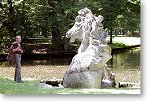German Sagas & Fairy Tales

The wonderful world of fairy tales, sagas, fables and legends is perfect reading for all those who enjoy learning a language but don't like to pore through long texts. Especially in German, some of the world's most famous figures of fairy tales and fables appeared in the original. Read on ...
Our latest news always on Facebook.com/sprachinstitut.treffpunkt.online
Private Online Lessons GERMAN 2025 |
| designations | portrait brothers Grimm | recommended links to sagas & fairy tales |
Designations
Because the same terms are sometimes used for these different types of tales, which are often extremely old and have been passed down through generations, we feel it would be a good idea to point out the differences between them:
- Fairy tale (German: Märchen) comes from the middle-high German word maere, which more or less means news or announcement. German fairy tales are usually imaginative stories in which natural law is suspended and miracles are the norm: For example, animals, plants and people can often talk and relate to one another. These worlds are also populated by magical helpers with fantastic means at their disposal!
Psychologically speaking, fairy tales are considered to be projections of human desires and fears.
- Sagas have to do with speaking, rumours, stories handed down from antiquity, and historical tales. Saga comes from the old Icelandic word saga, which was a term used in old Nordic literature to refer to written prose (beginning approx. in the 12th century).
- The word fable comes from the Latin fabula, which basically means story or tale. Fables are usually stories in which animals have the power to speak and reason, and thus serve as a mirror for - and reminder of - human morals and philosophies of life. Fables reached the highpoint of their popularity during the Age of Reformation (15th and 16th centuries).
- Legend comes from the Latin word legende, literally "that which is to be read". Legends are often folkloric tales that teach a lesson using the life of a saint as an example. In the past, legends frequently played a key role in the establishment of pilgrimages.
Portrait of the most popular storytellers in Germany: The Brothers Grimm
Almost exactly 200 years ago, at Christmas 1812, the first edition of the "Children's and Household Tales. Collected by the Brothers Grimm." was published in Berlin. Thus began the story of the second-most successful book in human history, beaten only by the Bible. Up to now, more than 1 billion copies in over 170 languages have been printed. However, these tales were not invented by the two brothers, Jacob (1785-1863) and Wilhelm (1786-1859) Grimm, but the result of their passion for collecting stories from story-tellers, mostly Hessian. Over the years, they put 156 stories on paper, which had been up to that time only passed on orally from one generation to the next. With the record on paper the tales became a harmonic work of language art, which saved authentic folklore from disappearing.
One of the brothers' acts of genius was the prologue formula "Once upon a time ...." with which (almost) all of their fairy tale begin. In fact, this is the original formula of telling all narrative literature. In the texts, sometimes harmless or simple religious stories were told, but most are distinguished by possessing something magical, which is indicative of their thinking which is afraid of no taboos. Literacy and education are social dynamics that characterize the period in which the tales were written down. Grimm's fairy tales have in this way become timelessly successful, across time and geography.
The two brothers grew up as sons of a civil servant in Hanau, Steinach and Kassel. They studied in Marburg and worked first as librarians in Kassel before they were appointed professors at Göttingen University in 182. They were politically active and were in opposition to their rulers both in Hessen and in Hanover. In 1837 they were among the "Göttingen Sieben", seven high-profile intellectuals who protested against a violation of the constitution perpetrated by elector Ernst August of Hanover. Therefore the brothers lost their positions. Years of work in Kassel and Berlin followed, before Jacob Grimm became one of the most prominent Members of the revolutionary parliament in the St. Paul's in Frankfurt in 1848. At the time of the death of the two brothers in 1859 and 1863, they had been working closely together their whole lives and became two of the most prominent social scientists in the German-speaking countries. Some references to the Brothers Grimm and their fairy tales are listed here:
- Brothers Grimm at Wikipedia
- Tales of Grimm at Wikipedia
- Märchenland Deutschland of the Goethe-Instituts
- The text book search at www.maerchenstiftung.ch
Our recommended links to sagas & fairy tales
- At ZUM you'll find plenty of links to different types of literature and fairly tales. It's a good place to browse - or even post a reference to your own website.
- A library of fairy tales, fables and sagas is a special section at the Gutenberg Project website.
- Fairy tale lexicon
- the following are links to fairy tales written by the authors most frequently read in Germany (Gutenberg Project):
- Fairy tales from Hans Christian Andersen (alphabetically by title)
- The Grimm Fairy Tales
We are interested in your personal experience and learning success. Also if you know other attractive offers. Please write to : info@learn-german-online.net.
